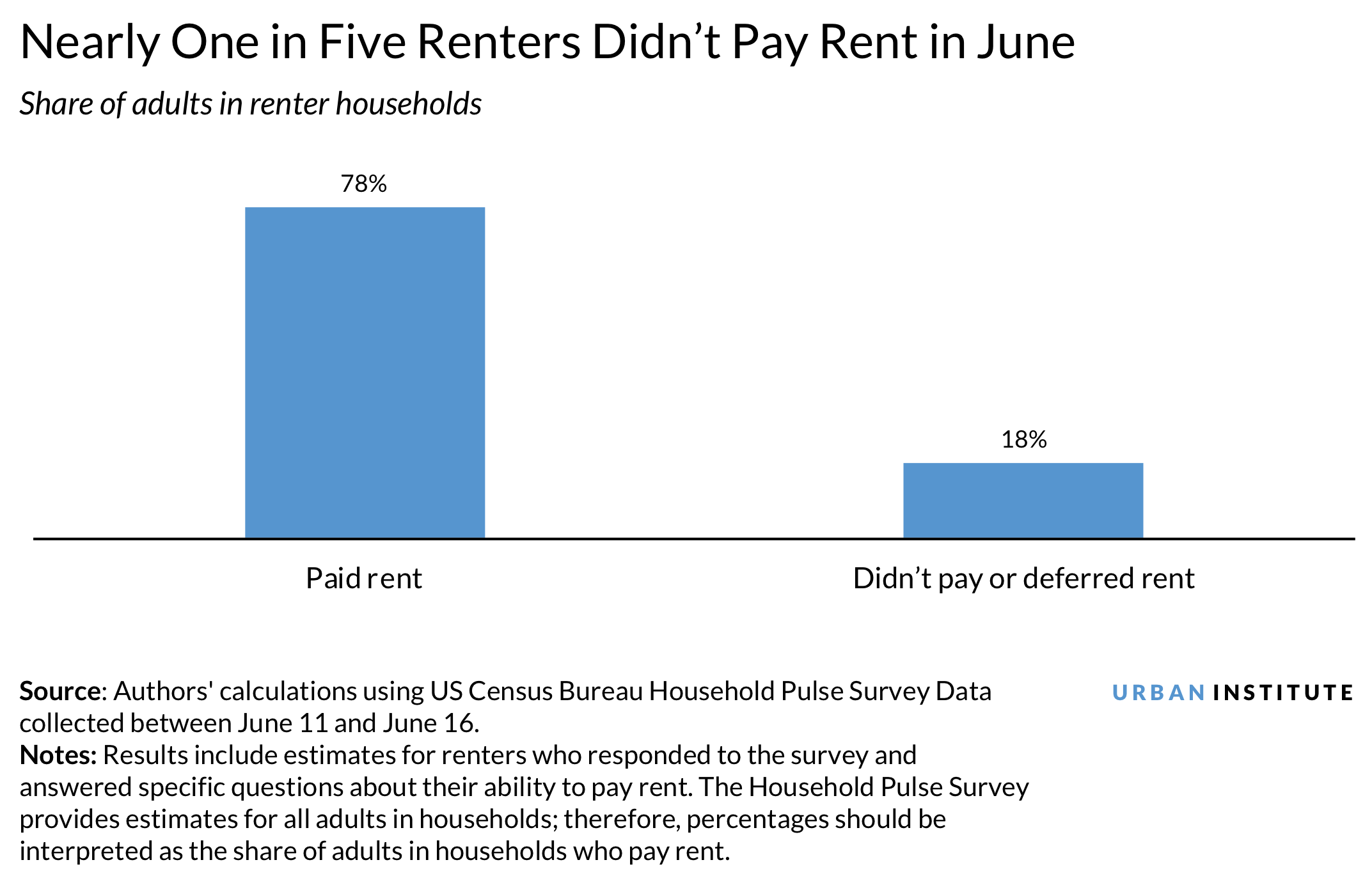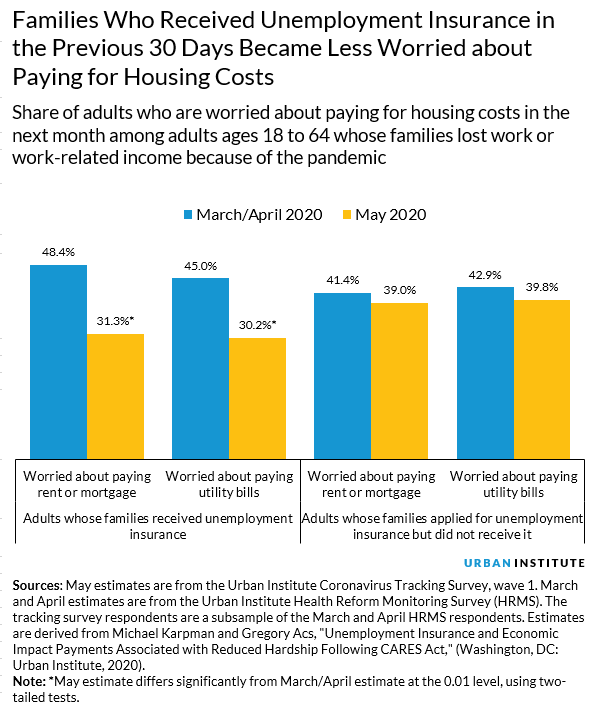
<p>A graffiti wall on La Brea Avenue in Los Angeles, California, calls for "No Wage No Rent" amid the COVID-19 pandemic on May 1, 2020. Several cities and states, including California, have passed executive orders prohibiting eviction of tenants affected by the coronavirus crisis. But when the lockdown lifts, the moratorium will end. And tenants will have to pay their back-rent or move out. (Photo by VALERIE MACON/AFP via Getty Images)</p>
American renters are racing in a car, headed toward the edge of a cliff, and the US government is standing by and watching. As we enter the fifth month of the COVID-19 crisis, unemployment levels are at 11 percent, more than 42 million workers (PDF) have filed for unemployment since mid-March, and experts say it may take a decade for the economy to fully recover.
COVID-19 cases continue to increase in the US, and ensuring Americans can socially distance relies on helping people stay in their homes. But new data suggest too many people are already facing eviction and millions more are at risk as eviction moratoria and supplemental unemployment insurance benefits are near an end.
Policymakers can take steps to keep renters from falling off the eviction cliff and prevent a surge in housing instability, which, for some can lead to homelessness. A Columbia University economist predicted homelessness could increase by as much as 45 percent this year. Supporting renters can also help address widening racial disparities in housing instability, as Black and Latinx Americans have been most effected by both the economic and public health impacts of COVID-19.
Eight percent of renters who have lost work face imminent eviction
New data from the Urban Institute’s Coronavirus Tracking Survey, a nationally representative survey of nonelderly adults conducted between May 14 and May 27 (with 93 percent of respondents completing the survey by May 20), show about 45 percent of renters report their families have lost work or work-related income because of the pandemic. Among these renters, 8 percent have received an eviction notice or been threatened with eviction since March 2020. About 4 percent of all adult renters reported facing eviction.
The number of people facing eviction has likely grown significantly since those responses were given, as there has already been a surge in news reports about people facing the threat of eviction.

These eviction threats come after months of warnings that renters were struggling to pay their bills. In mid-to-late May, about 14 percent of survey respondents reported problems paying their rent in the previous 30 days. That number was even higher among those who lost employment or income because of the pandemic, at about 24 percent. According to recent data collected between June 11 and June 16 by the US Census Bureau, nearly 18 percent of adults in renter households reported not being able to pay their rent in June.

Unfortunately, it’s about to get much worse.
The cliff: When eviction moratoria and supplemental unemployment payments end
Considering the high unemployment levels, the number of renters facing eviction has been lower than we’ve expected. This is partly because the protections that Congress and state and local officials put in place early in the pandemic are working for many people.
But the number of people facing eviction and homelessness will increase as protections are removed. Renters are facing two threats: the $600 extra weekly unemployment insurance payments are set to expire at the end of July, and most eviction moratoria have already expired or will very soon.
Unemployment insurance benefits have eased people’s concerns about paying for housing
In response to the unprecedented pandemic-induced financial strain, the federal government passed the Coronavirus Aid, Relief, and Economic Security (CARES) Act, which included Federal Pandemic Unemployment Compensation (FPUC) that provides an additional $600 a week to workers who lost their jobs during the COVID-19 pandemic. Many eligible people say they never received this benefit, but among those who could access unemployment insurance, FPUC has been critical to stabilizing many adults who lost their jobs.
A fifth of all American renter households have someone who lost a job because of COVID-19. But data from the Urban Institute’s Coronavirus Tracking Survey suggest unemployment benefits are protecting many families from hardship, and renters who applied for and received this support have a better outlook about their ability to pay future rent.
Among those who applied for and received unemployment insurance in the 30 days before taking the survey, the share of adults who were worried about paying their rent or mortgage dropped from 48 percent in March and April to 31 percent in May. Among those who applied for unemployment insurance but did not receive it in the 30 days before completing the survey, the share worried about paying their housing costs was largely unchanged.

FPUC is set to expire on July 31, 2020, and residents of certain states may stop receiving these benefits even sooner. Congress has not yet indicated if expansions of these programs will be included in future relief legislation.
Eviction moratoria have only delayed filings as rent piles up
Federal eviction protections for multifamily properties and US Department of Housing and Urban Development properties are set to expire on July 25, and the patchwork of state and local moratoria have already expired or are set to expire soon. According to data collected by Emily Benfer at Columbia University, as of July 1, only about two dozen states have eviction moratoria. Most state-level protections expired in April, May, and June.
The scopes of existing moratoria widely differ. Some states, like Indiana and Pennsylvania, maintain a moratorium on all evictions, while other states’ moratoria (like those in Alaska, Florida, and Maryland) only apply to evictions that—using nebulous standards—result from the pandemic. So even though a state might technically have an eviction moratorium, its scope might not actually protect renters. According to the Eviction Lab, eviction filings continue to increase.
Even with eviction moratoria, back rent is adding up. In Houston, landlords have filed 20,000 evictions since January, claiming more than $29 million in back-owed rent. Eviction protections Texas enacted in March have expired. Without additional rental assistance from the city, tenants will be taken to court and face laws that favor landlords, potentially forcing them out of their homes. In Virginia, the CARES Act–funded rental assistance program opened just days before July rent was due. Advocates say it’s not enough, and that it’s potentially too late to save many families from eviction.
Four ways to put the brakes on evictions
Even before COVID-19, America lived with too much homelessness and housing insecurity. Hundreds of thousands of Americans losing their housing in the middle of a pandemic and adding to the existing housing crisis will make it difficult to slow the spread of the coronavirus.
Hoping the economy will spring back, many policymakers have suggested a wait-and-see approach to the next set of relief bills. But as states cycle between reopening and reclosing amid spiking cases, it’s clear that without federal intervention, economic recovery will be long and uneven, leaving many people at risk of losing their housing. And until the public health aspects of the virus are addressed and testing is widely available, the economy will continue to suffer.
Four strategies can put prevent America’s renters from falling off the eviction cliff:
- Extend unemployment benefits for the next six months, at a minimum. The more than 40 million unemployed workers in the US may not be able to go back to work any time soon, and they will continue to struggle throughout this year and into 2021. FPUC has prevented catastrophe for thousands of families, but the expiration of this benefit could leave families facing the loss of their homes and financial stability.
- Fund enough rental assistance to meet the need. The need for rental assistance has only increased during the pandemic, with more renters than ever edging closer to eviction. Current rental assistance programs on both the federal and local level don’t have nearly enough funding to assist everyone in need. Fully funding assistance will keep all renters housed regardless of COVID-19 hardships and will support landlords. The Urban Institute estimates it would cost almost $16 billion per month to meet renters’ needs during this crisis.
- Pass a national eviction moratorium to ensure no one falls through the cracks. With housing courts opening back up, landlords are wasting no time filing to evict their tenants, even in states and cities with their own rental assistance programs or other COVID-19 eviction protections. A national moratorium on eviction is the only way to ensure families don’t lose their housing and to allow time for housing assistance to reach families in need.
- Fund legal assistance and pass right to counsel laws. Ideally, evictions are prevented before they are filed and hit the courts. But if a renter has to contest an eviction, data show that having legal assistance puts them on more equal footing with landlords who often show up to court with counsel. Some jurisdictions have passed right to counsel laws for tenants, which have helped stem a rise in evictions.
Without these critical steps, renters will go over the eviction cliff, and the country could land in a place similar to during the Great Depression, when a lack of federal response to mass unemployment led to a surge in people sleeping outside in encampments, nicknamed “Hoovervilles” after President Herbert Hoover. Letting renters go over the cliff will not only cause immense suffering for families who lose their homes; it will also make it difficult for the country to contain the coronavirus.
Let’s build a future where everyone, everywhere has the opportunity and power to thrive
Urban is more determined than ever to partner with changemakers to unlock opportunities that give people across the country a fair shot at reaching their fullest potential. Invest in Urban to power this type of work.